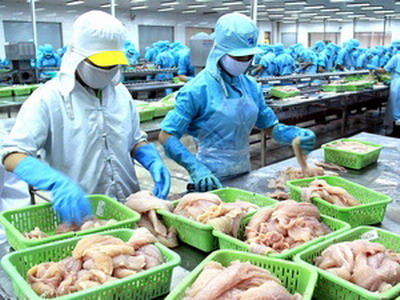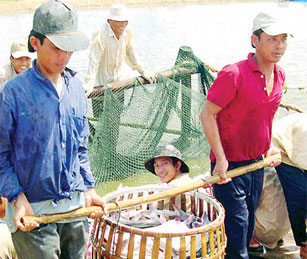Farm economy booms in Mekong Delta
 |
| Workers process basa fish for export at the Binh An Seafood Company in Can Tho Province (Photo: VNA) |
The region, which is endowed with favorable natural conditions, now has 40,000 farms, accounting for 27 per cent of the country’s total number of farms. In its coastal areas, many farms of black tiger shrimp, crab, blood cockle, clam, etc. are working busily; and in its freshwater zones, tra and basa fish, giant river prawn, and some others of high value are bred on large scales.
Sharing profit and risks
In Tran De District, Soc Trang Province, tens of large shrimp farms are scattered on an area of 5,000 ha along the banks of My Thanh River. Those farms employ thousands of workers and each farm can earn billions dong every harvest season.
Mr. Thong Nhut, a local farm owner, said: “We produce shrimp according to a closely organized and controlled system, including breed selection, breeding-pool design, water supply and treatment, feed, care and harvest, so we can optimize the products quality. Meanwhile, the shrimp consumption is ensured by our long-term contracts with shrimp processors and exporters in the province.”
In many areas in An Giang and Dong Thap Provinces and in Thot Not and O Mon Districts of Can Tho City, the breeding of tra and basa fish has been developed vigorously. Most of the fish farms are built along the banks of the Tien and Hau Rivers. Thanks to the favorable natural conditions, including an abundant water resource, the quality of tra fish produced is quite high, meeting the export standards.
With a view to doing business sustainably, Nguyen Ngoc Hai, the owner of a large-scale tra fish farm in Thoi An commune, O Mon District, Can Tho City, set up a cooperation with a seafood processing company in Tien Giang Province on the principle of “sharing profit and risks”. He called on other farm owners to join him in the long-term cooperation.
“In this model, our farms operate together in the form of a cooperative. We are responsible for breeding, care, and management under the supervision of that company, which is in charge of supplying feeds and consuming all the cooperation’s production. In the past two years, our profit rates have ranged from 15 to 25 per cent per harvest season,” he said.
Under the model, the cooperative represented by Nguyen Ngoc Hai has developed efficiently, with its yearly production amounting to 30,000 tons of tra fish, or 90 percent of the total production of O Mon District.
Meanwhile, Soc Trang Province has recently emerged as a livestock breeding hub in the region. Pham Van Du, the owner of a large farm in Ho Dac Kien Commune, Chau Thanh District, said both the farm’s input and output were kept stably thanks to his cooperation with the CP-VN joint stock company.
The farm now rears around 100,000 chickens for meat, 60,000 chickens for eggs, and 2,200 pigs for meat and breeding purposes. Every year, it earns a total profit of about VND4 billion ($200,000). In the district alone, the number of large-scale farms like Du’s is more than 40.
 |
| Farmers harvest tra fish, one of the key products of the farm economy in the Mekong Delta |
Quach Van Tay, the head of the Breeding Division of the provincial Department of Agriculture and Rural Development, said the province now has 181 farms of pigs, milking cows and poultry. “Those farms are thriving owning to applying scientific and technological advances to production. They now employ thousands of workers,” he said.
Square-head anabas emerges in Hau Giang
In recent years, the production of square-head anabas has developed as a new aquaculture model in the Mekong Delta since a farm in Vi Thuy District, Hau Giang province, was successful in trial production.
Nguyen Van Khai, the owner of the farm, said that he began raising square-head anabas in 2008. The fish grew up very fast, weighing 100 - 150g after just three months of breeding. After harvesting, he sold 11 tons of the fish for VND30,000 per kg and got a profit of about VND200 milion ($10,000). “Square-head anabas brings about more economic efficiency than common one,” he said.
He has since expanded the production of square-head anabas and provided the breeding fish for other farms. Currently, the fish is raised across the province and in its neighborhoods. It sells well on the market since its meat is very delicious. The province Agriculture and Rural Development Department is carrying out the application for registration of a brand name for this specialty fish.
“Kingdom of flowers, bonsais”
With a great deal of farms well known for ornamental flowers and plants for export, Ben Tre has been dubbed as the “Kingdom of Flowers.” Most farms in the province’s Cho Lach district have become well-off thanks to the increasingly growing number of orders both at home and from abroad.
Those farms possess hundreds of kinds of ornamental plants and flowers. Every Tet (lunar New Year Festival), they can market 6-9 million of products of high quality, including rare and precious ones. Recently, famous bonsai growers like Xuan Hoang, Nguyet Thu, Ly Hai, Bay Xuyen, etc. have launched a series of unique ornamental plants with the shapes of animals.
Especially, Nguyen Van Cong, the owner of a large establishment in Hưng Khanh Trung B, Cho Lach District, has produced special bonsais under the orders placed by foreign companies. Every year, he exported about 200 plants with the shapes of hexagonal and octagonal houses to Singapore and Japan.
Cho Lach now has about 8,000 family establishments, or 30 per cent of its total number of households, that provide plants and flowers for ornamental purposes. They can yearly market 6-8 million flower plants and 16-20 million of bonsai seedlings, earning a total profit of about VND100 billion ($5 million).
What the stars mean:
★ Poor ★ ★ Promising ★★★ Good ★★★★ Very good ★★★★★ Exceptional
 Tag:
Tag:
Related Contents
Latest News
More News
- Partnerships drive sustainable finance (January 07, 2026 | 09:23)
- FDI inflows reach $38.42 billion in 2025 (January 06, 2026 | 17:55)
- $2.1 billion Nghi Son LNG-fired thermal power plant waits for investor (January 06, 2026 | 17:51)
- GE Vernova powers up Vietnam with first 9HA gas power plant in the country (January 06, 2026 | 16:54)
- Solid finish for manufacturing after volatile year (January 06, 2026 | 08:50)
- Meiko strengthens Vietnam operations with new PCB plants (January 06, 2026 | 08:49)
- Ho Chi Minh City backs $2 billion AI data centre with dedicated task force (January 06, 2026 | 08:43)
- PM sets January deadline for high-speed rail consultant (January 06, 2026 | 08:40)
- New decree spurs on PPP implementation (December 31, 2025 | 19:01)
- Global alliance develops $1 billion AI data centre network in Vietnam (December 30, 2025 | 10:08)






















 Mobile Version
Mobile Version